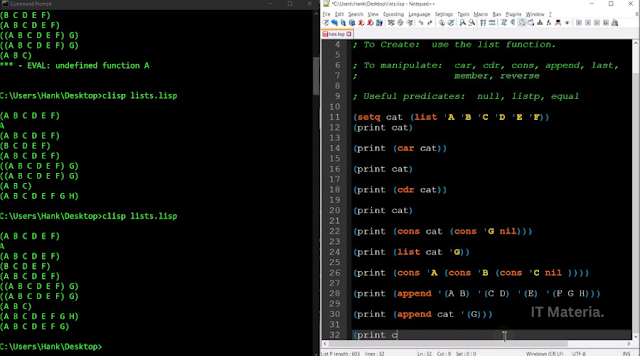Lisp is a programming language that was created by John McCarthy in 1958. The name Lisp stands for "LISt Processing" and reflects its primary focus on manipulating lists and symbolic expressions. Lisp is known for its unique syntax, which is based on parentheses and prefix notation, and its powerful metaprogramming capabilities.
One of the defining features of Lisp is its homoiconicity, which means that code and data share the same structure. In Lisp, programs are typically represented as lists, where each element of the list can be either data or code. This allows Lisp programs to be treated as data, enabling powerful metaprogramming techniques. Lisp programs can generate and manipulate other Lisp programs dynamically, making it a highly flexible and expressive language.
Lisp introduced the concept of "atoms" and "lists" as fundamental data types. Atoms can be symbols, numbers, or characters, while lists are collections of atoms or other lists. Lisp provides a rich set of built-in functions called "special forms" and "primitive functions" for manipulating atoms and lists. These functions allow for operations such as list creation, element access, concatenation, and modification.
One of the key strengths of Lisp is its macro system. Macros in Lisp enable developers to extend the language by defining their own syntactic constructs. With macros, programmers can create domain-specific languages (DSLs) tailored to specific problem domains. Macros allow for code transformations and abstraction, making Lisp a highly flexible language for expressing complex ideas.
Over the years, Lisp has evolved and influenced the development of other programming languages. One notable dialect is Common Lisp, which is a standardized and feature-rich version of Lisp. Common Lisp incorporates numerous enhancements and extensions, such as object-oriented programming support through the Common Lisp Object System (CLOS).
Another popular Lisp dialect is Scheme, which emphasizes simplicity and minimalism. Scheme adheres to a minimal core language specification known as the "Revised Report on the Algorithmic Language Scheme," which defines a small set of essential features and encourages implementation flexibility.
In recent years, a modern Lisp dialect called Clojure has gained popularity. Clojure runs on the Java Virtual Machine (JVM) and emphasizes immutability, functional programming, and concurrency. Clojure combines Lisp's expressive power with the ecosystem and libraries of the Java platform.
Lisp has found applications in various domains. In the field of artificial intelligence (AI), Lisp has been widely used for symbolic computation, knowledge representation, and expert systems. Lisp's emphasis on symbolic expressions makes it well-suited for AI tasks that require manipulating and reasoning about symbolic data.
Lisp has also been utilized in language processing, where its flexible syntax and metaprogramming capabilities have been leveraged to develop parsers, compilers, and domain-specific languages for processing natural language.
Despite its historical significance and ongoing relevance in specific domains, Lisp is not as widely used in mainstream programming as languages like Python or Java. The parentheses-heavy syntax and the learning curve associated with Lisp's unique features can be barriers for newcomers. However, Lisp's expressive power, metaprogramming capabilities, and rich ecosystem of libraries and tools make it a powerful language for prototyping, exploring new ideas, and tackling complex problems.


.png)
.png)